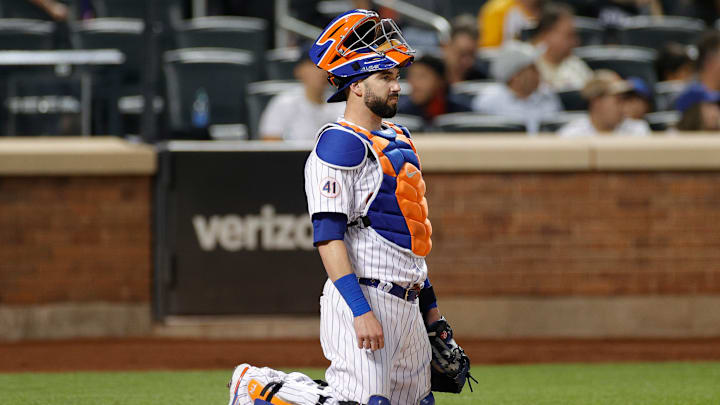In the history of the New York Mets, 101 different players have appeared behind home plate. Just nine have done so in at least six seasons.
Tomás Nido just became the most recent one to do so.
On the surface, his stat line doesn’t look like anything special. His career OPS is well under .600 and his OPS+ is under 55, both of which are among the worst of anyone who has played at least 100 games at catcher since 2017 when Nido debuted.
For Nido though, you can’t just look at his slash line. The value that he brings is buried deeper below the surface … or, you know, on Baseball Savant.
Nido is quite simply one of the best defensive backstops in Major League Baseball, and probably the best the Mets have had in a long time.
Let’s start with catcher framing, which Baseball Savant defines as “the art of a catcher receiving a pitch in a way that makes it more likely for an umpire to call it a strike.”
Essentially, it’s a measure of how good a catcher is at tricking the umpire into thinking a ball is a strike. Sure, there’s more to it than that, but that’s basically it — and it’s way more fun to describe it that way.
In 2021, Nido ranked in the 100th percentile in baseball. That’s more than good, it’s literally the best in all of baseball. He had a 53.5% strike rate last season which was second to none, and his five catcher framing runs was No. 7.
Nido’s framing has always been good, but it took a real step up in 2021. In the only other season he qualified for the framing leaderboards, 2019, he was in the 73rd percentile. Still very respectable, but he’s clearly elevated himself to an elite level.
Speaking of Nido’s 2019 season, something else really stands out on his Savant page — his pop time to second base. That, like his 2021 framing numbers, has to squeeze three digits into the small red circle — 100. Once again, we find Nido is in the 100th percentile in a catcher fielding metric.
Pop time, per Baseball Savant, “measures the time from the moment the pitch hits the catcher’s mitt to the moment the ball reaches the fielder’s projected receiving point at the center of the base.”
In 2019, Nido’s average pop time to second base was 1.93 seconds, only trailing Austin Hedges, Willson Contreras, Jake Rogers and J.T. Realmuto.
He was also in the 100th percentile in pop time in 2018, the only other year he has data for. After 2019, there is no pop time data available for anyone, but it’s safe to say Nido has passed the eye test since then.
If that’s not good enough, there’s proof. In 2021, of catchers with a minimum of 10 stolen base attempts against, he was tied for the league lead in caught stealing percentage at 57.1% — throwing out 12 of 21 would-be base stealers. The aforementioned Rogers was tied with him in percentage, throwing out eight of 14. Salvador Perez was third at 43.9% (18 of 41).
Nido was the only catcher in baseball in 2021 who was in the top-10 in both strike rate and caught stealing percentage. No Realmuto. No Yadier Molina. No Jacob Stallings. No Tucker Barnhart. No Buster Posey. Those are the only players who have won the NL Gold Glove at catcher since 2008. None of them were as good as Nido behind the plate in 2021.
Sure, his bat might leave a lot to be desired, and it prevents him from being an everyday catcher — but Nido is still a legitimately valuable piece to this Mets roster. It’s not random that Mets pitchers, most notably Jacob deGrom and Noah Syndergaard, have very obviously loved having him behind the plate while they’re on the mound.
Nido is great at what he does. In fact, he’s probably the best. And what he does is important.
